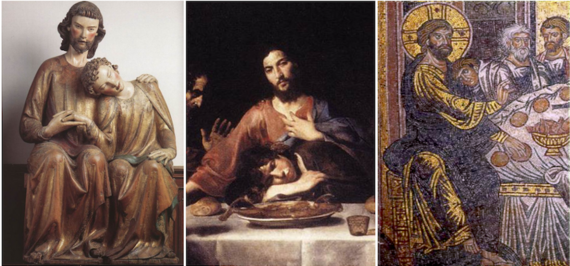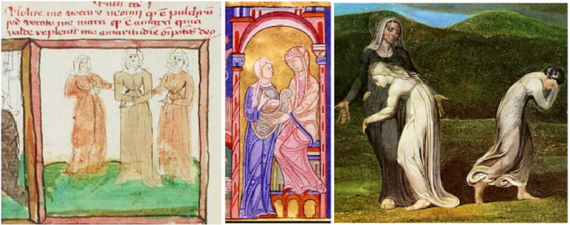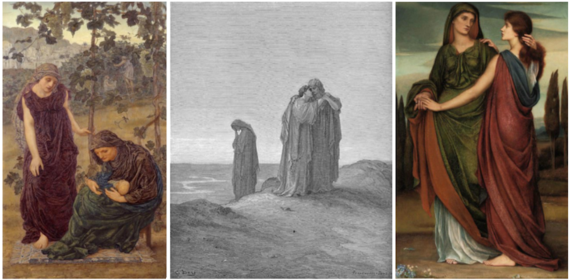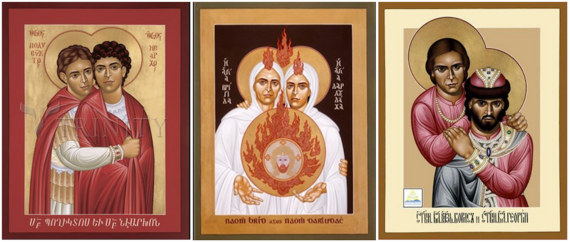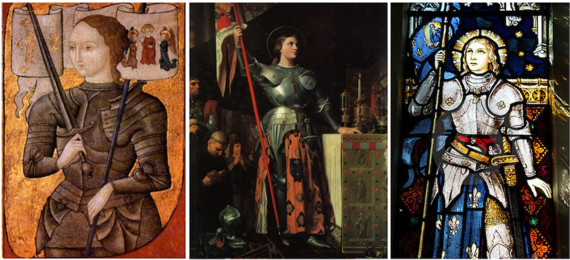What would happen if the LGBT community did something that no one in the state of Indiana, and apparently no one in the US mainstream media, has gone on record expecting us to do? That is, what if we lesbians, gays, bisexuals and transsexuals claim our entitlement to and protection under the so-called Indiana "Religious Freedom" law sponsored by Governor Mike Pence (which after the initial outcry is now undergoing amendment talks). For all that LGBT Americans would need to do to be covered under the Religious Freedom Law as individuals and as married citizens is to claim that we and our marriages are partaking in a religion or spiritual calling.
I don't mean that we on the spot improvise or fake a ritual and liturgy that purports to sanctify same-sex unions. There's no need for such desperate tactics, given that same-sex relations are already being included in certain liberal Christian churches. Same-sex unions are also being blessed increasingly in Buddhist and Hindu temples and recently Reformed Judaic temples receive gay and lesbian weddings, even some Sufi mosques quietly support same-sex unions while acknowledging the long history of homoeroticism in Islamic civilization. And of course various Native American tribes have long held two-spirit unions to be sacred.
If I keep now to a Christian history of same-sex unions, it is because Christianity is the faith claimed by the predominate opponents of same-sex marriage in Indiana and the US, those we must now address with our challenge. But the history of Christianity also yields fertile ground for the gay activist since research by Christian-religion historians in recent decades has unearthed much evidence confirming that same-sex unions were included within the universal Christian community throughout the first twelve centuries, and by some accounts at its origins. It even has been confirmed that in the medieval centuries some churches ministered authentic matrimonial liturgies to same-sex couples despite the waves of anathema that were aimed at same-sex relations by various Church Fathers in Rome and Constantinople after the fourth and fifth centuries--though even such hostility was not always in response to the issue of their sexual difference.
In retrospect, sexual difference hardly ranks as a concern in the Christian scripture. If we judge the importance of homosexuality to the authors of the Bible according to the number of times it is remarked on, whether negatively or positively, it ranks at the bottom for being barely mentioned in the Old Testament and not at all by Christ in the New Testament. By contrast, if all of the virtues remarked on in the Bible were to be ranked by frequency of citation, Love would tower above all the others. On this basis, the supposed wrongness of homosexuality is clearly not crucial to Christianity when compared to all other ethical concerns, while the basis of same-sex marriage is entirely a condition of love, making it an exemplary Christian virtue -- a logic and sentiment it turns out was shared by numerous Christian saints who had shared in same-sex partnerships.
Unfortunately, today's Catholic and Orthodox clergies remain largely unaware or in denial that there were once nuptial liturgies performed by priests just for same-sex congregants of certain local parishes. Even among scholars who know of the same-sex unions, there is considerable debate over whether or not the unions were joined for sexual relations or merely in the spirit of brotherly and sisterly love. Such a maintenance of chastity is consistent with the vows taken by the clergy dating back to the first generations of Jewish followers of Jesus. But even in such cases, the scholars don't deny that the unions being sanctified by the Church were unions of love. And, certainly, even in the unions that were secretly carnal, the sanctity of the nuptial proceedings by the ecclesiastical doctrines of the day could not be declared null and void where the love between two conjoined adults is concerned. We need only recall that Divorce was a hard-won legal right in most Christian nations only after the Protestant Reformation, some sixteen-hundred years after the first Christian marriage vows had been ordained. Even today, the Catholic Church officially holds marriage to be an indissoluble bond.
But even without the Church's continued support, we should ask why so many Americans, and especially so many media commentators, assumed that the LGBT community has no religious convictions of their own to be protected under the new Indiana law.
The truth is that when the churches and temples and mosques fill up, there are LGBT people there. Many of us.
We can hardly blame the Indiana Christians for not being aware of the full history of Christianity when so many LGBT people -- when so many people of all persuasions -- are unaware that same sex marriages were sanctioned by the Roman and Greek churches between the fourth and the twelfth centuries. But now is a perfectly good time for us all to learn about the various enclaves of Christianity that condoned and even officiated same-sex marriages. It's an even better time for same-sex marrieds to proclaim their marriages, their partners, their lives, their sexualities as essential aspects of their personal religions, whether or not they belong to an institutionalized religion.
And then, in Indiana, Christian LGBT individuals can in good conscience claim that their religion had historically condoned same sex marriage, and like all the other religions in Indiana, their religious convictions must be protected by Indiana Governor Mike Pence and his constituency. Even before we consider the histories of same-sex relations of other faiths, this much will impact on the media's narrow representation of same-sex marriage so to expand that coverage to include coverage of all same-sex friendly religions or subcultures both historically and today.
A wave of debate and change can issue by revealing to the world the history of Christian inclusiveness that has been lost and forgotten by all but a small enclave of medieval historians, progressive Christian theologians, clerics, and scholars schooled in the development of sex and gender codes of the Mediterranean rim of Europe, North Africa and Asia. Until now, these are the few people who have been aware of the gay, lesbian and transgender saints and the biblical protagonists who were venerated in local diocese the world over. It will no doubt astonish many Christians to learn -- and learn we must so to reclaim what we lost -- that at some time in the history of the Christian faith, such prominent biblical same-sex couples as Ruth and Naomi, David and Jonathan, even Jesus and St. John the Evangelist, had been invoked in the prayers and the blessings of the sanctified same-sex unions. And that is before we get to considering the list of Christian saints and martyrs called on in private and personal Christian prayers around the world.
This is not a lampoon. This is not disrespect of anyone's present faith. This is the historically-recorded identification of devout worshippers who preferred love and life with a member of his or her own sex and thereby saw themselves fulfilling the teaching in Genesis of being made in the image of their God. Not only did certain Christian communities right up through the Renaissance take the Evangelist John's word literally when he wrote that he was the disciple that Jesus loved, the Roman churches of Western Europe and North Africa and the Eastern Orthodox churches of Greece, Turkey, Russia and Asia beatified several pairs of same-sex unions. St. Sergius and St. Bacchus were so highly esteemed by the Byzantine Orthodoxy that they were conferred their own Church of St. Sergius and St.Bacchus in what was in 530 CE the largest city in the world -- Constantinople -- or what is today Istanbul. Today the church is considered so important in the history of sacred architecture that it is known as "Little Hagia Sophia" for being designed by the same Byzantine architects, Isidoros and Anthemios, who went on to build the great Hagia Sofia, one of the most celebrated architectural treasures in the world -- though it is but a larger version of the Sts. Sergius and Bacchus church.
In fact we know much of the history of Christian same-sex unions because, as is so often the case, the art that survives the era depicts a distinct contradiction to the sex and gender attitudes predominant in our own time. Artists have historically bequeathed capacious evidence for the evolution of societal values, norms, and cultural codification spanning tens of thousands of years, with the last three to four thousand years of global art comprising a near-continuous artistic narration of human sexuality and gender. Art accompanied, if not at times precipitated and contributed to, the upheavals of tribes, states, and civilizations. It's only to be expected that art also plays a decisive role in the dissemination, legislation, and perpetuation of sex and gender codes.
Painted icons from the Greek Church and memorial sculpture in fourth and fifth century Roman and Greek cemeteries not only continue the earlier, so-called "pagan" traditions of depicting not just same-sex lovers, but couples joined in their sacrament of matrimony, and whose burial together by Christian belief was thought to better ensure their joint resurrection. In the case of sixth-century Byzantium, the evidence of same-sex couples is archeological as well. Valerie Abrahamsen, whose specialty is New Testament archaeology in Greece, writes in Burials in Greek Macedonia: Possible Evidence for Same-Sex Committed Relationships in Early Christianity :
"Burials of pairs of men and pairs of women in ecclesiastical contexts from the early Byzantine era [fourth to sixth centuries], along with more expected burials of married couples, families and random groups, have been discovered in excavations at Philippi and Edessa in northern Greece... the primary evidence for same-sex unions from the Byzantine period is archaeological and epigraphic... In four cases the evidence for same-sex burials is unmistakable: two pairs of women (Euodiana and Dorothea, Pancharia and Posidonia) and two pairs of men (Gourasios and Konstantios, Faustinos and Donatos)."
In her book Love Between Women: Early Christian Responses to Female Homoeroticism, feminist religious scholar, Bernadette J. Brooen, has collected formidable evidence for women's homosexuality, homoeroticism and same-sex coupling in Roman religious societies, including early Christian communities.
"As Christianity took hold, women formed communities or houses closely parallel to those of men. Such groups were governed by specific rules, disciplines and hierarchies, and focused on such tasks as caring for the poor and sick, educating young girls, copying manuscripts and weaving textiles. Girls lived in many Christian convents from very young ages if they were students, early recruits or orphans. These communities provided favorable conditions for same-sex love [and] led early Christian writers to a heightened awareness of homoerotic attraction. It is clear from the literature that women consciously chose this lifestyle instead of traditional marriage and that this choice was often seen by male church leaders, including John Chrysostom and Augustine, as problematic."
Of course the lesbian life choice was an offshoot of the sexual freedom of pre-Christian Rome. An Augustan funerary relief dating from 3 CE in the British Museum depicts two women with their right hands clasped together in the gesture that expresses commitment. [The theologian, Mary Rose D'Angelo.] writes of this relief:
"The inscription gives their names as Fonteia Eleusis and Fonteia Helena, further identifying them as freedwomen of a woman of the gens Fonteia. In late antiquity the stone had been recut; the veils of the women were cut away and the face of one recut to make her look like a man, while the other was given a wedding ring. Presumably the reviser hoped to turn the relief into a conventional funerary portrait of husband and wife.... The recutting was probably suggested by the handclasp, which is frequently (though not exclusively) used to depict the marriage bond."
It should be no surprise that Greece and Rome provide us the sites of same-sex burials given that, despite Paul of Tarsus condemning such enclaves, the more moderate Christian proselytizers in Greece, Rome and Egypt had to contend with baptizing populations accustomed to having homosexuality openly on display as a desirable life choice, as the history of art affirms. What is surprising, shocking when it was first asserted in the book by the late Yale historian John Boswell, Same-Sex Unions in PreModern Europe, is the revelation that there was an official Christian liturgy for same-sex unions among the Greek Christian worshippers -- both joining a man with a man and a woman with a woman. It is from this liturgy and Boswell's comparison of them with the liturgy of heterosexual unions that we can ascertain that from the fourth to the eleventh centuries the emphasis in both liturgies is solely on the spiritual bond between two people and pays little attention to the same sex or opposite sexes.
Boswell writes, "The wording of the ceremony of same-sex union is similar in many striking ways to that of medieval Greek heterosexual ceremonies. ... Relatively few other services have litanies at all." Boswell also significantly notes that both the heterosexual and the same-sex union liturgies "appear to have developed chiefly out of the commemorations of apostolic peace," which indicates that both heterosexual and same-sex unions during the first millennia of Christianity were not meant to provide erotic fulfillment as they do today. What marital unions were to supply was a life of harmony and peace with God. And yet, one of the liturgical prayers used in both the Greek heterosexual and same-sexual marriage ceremonies implores of the Holy Spirit, "that with pure heart and good conscience we may kiss each other with an holy kiss ... one in body and spirit, one in faith, as we were called in one hope thereunto ... now and forever."
Despite the expected dissent of prominent scholars and ecclesiastics, Boswell's lead was followed by Alan Bray, who translated a Latin Catholic same-sex rite from Slovenia as the "Order for the making of brothers". And after him, Allan Tulchin found that unrelated same-sex French Christians are recorded in parish records to have been joined in legal union to raise family and jointly-owned property.
As for why homosexuals in the fourth century became anathema to such Church Fathers as St. Ambrose of Milan, St. Athanasius of Alexandria and the Christian Roman Emperor, Justinian, one interpretation has it that homosexual men were not initially condemned by the first Christian Fathers (the Nicene Fathers who formulated the Catholic doctrine of the fourth century) because of their sexuality. Homosexuals, many of whom the Christian Fathers knew as eunuchs, were debased and sentenced to death as heretics for having been their powerful opponents who lost the strategic doctrinal debate over whether Christ was the divine son of God the Father or merely adopted by God as his earthly, human son. The losers of the debate, eunuchs and homosexuals, were known as Arians and their view became condemned as The Arian Heresy. As far as this interpretation of the Arian controversy goes, homosexuality was only criminalized because the eunuchs who could not father were viewed by the Nicene Fathers as essentially unwilling to accept a God who did father. With so many eunuchs being homosexual, all same-sex unions now became suspect and criminalized as heretical, even if as only a pretext to punish and eradicate the Arians.
Interestingly, the Nicene Fathers in their lust for power in the Church, seem to have ignored the counsel of Jesus, in Matthew 19:12 (King James Bible), just as most theologians have overlooked the possibility that in his remark on the eunuch, Jesus may have implied many things about many kinds of people outside the heterosexual mainstream, whether by nature or by desire.
"For there are some eunuchs, which were so born from their mother's womb: and there are some eunuchs, which were made eunuchs of men: and there be eunuchs, which have made themselves eunuchs for the kingdom of heaven's sake. He that is able to receive it, let him receive it."
Even as the Nicene Fathers ignored the counsel of Jesus to respect the eunuch as he receives his sexual difference, we may heed it, and more than heed it, we may regard it as Jesus' testament that the eunuch (that is, metaphorically, the same-sex or transgendered individual) can legitimately be received by the Church and community of Christians.
If you are shocked or feel blasphemed by such historical disclosures, or betrayed by your teachers for their neglect of this history, go easy on yourself and them. It is because they, like you, have been led to misunderstand what homoeroticism, what same-sex bonds in love and friendship, are. Chiefly, the same-sex union is not only genital.
In the 1970s, Audre Lord addressed women with her enhanced awareness of what is erotic for heterosexuals and homosexuals, but it applies to men as well.
"The erotic has often been misnamed ... made into the confused, the trivial, the psychotic, and plasticized sensation. For this reason, we have turned away from the exploration and consideration of the erotic as a source of power and information, confusing it with the pornographic. But pornography is a direct denial of the power of the erotic, for it represents the suppression of true feeling. Pornography emphasizes sensation without feeling. The erotic is a measure between our sense of self and the chaos of our strongest feelings. It is an internal sense of satisfaction to which, once we have experienced it, we know we can aspire. For having experienced the fullness of this depth of feeling and recognizing its power, in honor and self-respect we can require no less of ourselves."
Walt Whitman similarly saw the sacred power of the erotic as fusion of self and other.
I celebrate myself, and sing myself,
what I assume you shall assume,
every atom belonging to me as good belongs to you.
Why didn't anyone tell us all this before? Adrienne Rich called the formidable historical and societal blockage Compulsory Heterosexuality to explain the ancient sociological juggernaut that historical populations erected to subdue the absurd fear of their own tribal, racial and religious extinction. In the millennia in which war, famine, plague and natural catastrophe wiped out whole populations in relatively no time, the pleasure of recreational sexuality must have been feared as a deadly distraction from the procreative imperative required to keep the tribe, the city-state, the nation, and the faith in fresh supply of manpower (soldiers, slaves, laborers). For many smaller nations and communities, such existential imperatives still seem vital, despite that today's genome science discerns that homosexuality can be explained as Nature's biological provision ensuring the stabilization of population growth, and thereby affords the ubiquitous queer sensibility a reason for being. (See "Homosexuality as Population Control? Why Gays & Lesbians Are Essential to the Balance of Nature.")
Many of us ask, If same-sex relations were always so urgent and ubiquitous, why is it our history books don't show this? Why don't more people, especially Christians and Jews know this? The answers are too numerous to account for here, but the primary historical narrative informs us that in the 11th century, as the Eastern and Western Churches were torn apart by ecclesiastical and theological differences, the schism that ensued in the eleventh century effectively enabled the popes in the West and the patriarchs in the East to accrue more power by centralizing their respective bishoprics around their seats in Rome and Constantinople. By the 12th century, both Churches were crumbling from within as ordinary Christians accused the clergy and bishops of being corrupt. Among the charges were those of sexual impropriety, if not an orgiastic hedonism indulged by monastics--which being largely homosocial enclaves, would naturally encourage both enthusiastic homoeroticism within and its zealous detractors from without.
Although the Church was ultimately saved by the reforms on the clergy that had begun in earnest with the demands of piety and austerity implored by the religious commoners in the 12th century, by the 14th century, with the Renaissance in full bloom, the Western Church grew even more ambitious for territory, power and a taste for ostentatious acquisitions that seemed to know no earthly bounds. Simultaneously, the emergence of a dissenting Protestantism born with Luther and Calvin in the 16th century, imposed more widespread and severe restraints on sexuality outside heterosexual marriage. Whatever excesses had permeated Christian Europe with the Renaissance ultimately gave rise to an army of apostates. In turn, the oppressive hand of the Church clenched into a fist to batter its own congregants into submission before the Grand Inquisition. As widespread arrests, imprisonment and tortures, grew, Europe became a landscape given over to the entrenchments of religious wars.
Jews, too, living in Christian nations found their fears of persecution exasperated at a time when their Midrash amendments to the Torah obscured any homoeroticism implicit in the accounts of David with Jonathan, and Ruth with Naomi. Interestingly, Jews in Islamic nations from Spain to India at the same time enjoyed a flowering of homoeroticism, as by this time the more territorially-secure, and thus the more liberal caliphates of Islam, turned a blind eye not only to Jewish social life, but to the homoeroticism that now flourished among both Jews and Muslims whose lives were enhanced by the rise of merchandising, trade and the spread of usury.
When homosexuals and their relationships become invisible in Christian history, Adrienne Rich provides one recourse for seeing through the screen of historical heterosexual colonization to the basic acts of humans in perpetual contact, a contact through which a queerness persists and might even be glimpsed. Rich's vision is as elegant in its simplicity as it was radical when first proposed in 1980. As the same-sex proclivity is not only about sex, the enclaves of men's and women's compulsory heterosexuality casts a shadow over all but the most overt actions of friends and colleagues. But through these acts we often gain sight of the nuances that distinguish friendship from desire, even if the desire isn't reciprocated or consummated. We don't see the eroticism of the same-sex relation because other shadings are more significant, even urgent. Regarding what makes a lesbian, for instance, Rich holds that she isn't just a person who prefers sex with a woman.
"If we consider the possibility that all women -- from the infant suckling her mother's breast, to the grown woman experiencing orgasmic sensations while suckling her own child, perhaps recalling her mother's milk-smell in her own ... to the woman dying at ninety, touched and handled by women -- exist on a lesbian continuum, we can see ourselves as moving in and out of this continuum, whether we identify ourselves as lesbian or not."
Of course the same goes for all men, who sociologists have observed at around the age of five begin to separate themselves from girls to enjoy the mysterious allure of male-only camaraderie, which continues for many throughout life in the gym, in the fraternity, in the military, in the career conclaves of lawyers, stockbrokers, politicians, felons. It is to discourage women's intervention on the male homosocial enclave and on the bond cementing that enclave which explains why women have such a hard time competing to attain equal status and pay. And that fraternity among the compulsory heterosexual enclave is not so different from that inside the homosexual enclave, where even among gay men affection may be rarely acknowledged outside of the bedroom or the sex club and often granted the same semblance of unconcern as that displayed by heterosexual men.
So nuanced are the similarities and differences between homosexuality and heterosexuality it seems that if there is a boundary to be observed between them it is a porous one, and this is why we don't know the extent of the homoeroticism flowing even within our own religious and secular histories and cultures. Desire plays out discretely, but assuredly, between men, and between women, often without letting the other sex know. Often without their even wanting to know. But certainly desire proceeds from generation to generation, as Whitman also celebrates.
My tongue, every atom of my blood, form'd from this soil, this air,
Born here of parents born here from parents the same, and their parents the same,
But again, it is likely that Christian same-sex couples are in the best position to counter the Indiana bigots on their own terms. For as the bigots claim it is their Christian faith that compels them to discriminate against LGBT couples, the LGBT couples can in return claim that it is their love for one another that honors the true teaching that Christ relayed to us through his beloved disciple John (at the very same Passover supper that John lays his head on Jesus' chest) . "A new commandment I give to you, that you love one another, even as I have loved you, that you also love one another." (John 13:34)
It is this new testament of love that overturns the old judgements of Genesis and Leviticus against same-sex relations, just as it overturns the myth of defilement projected onto women. By Jewish law, women were to be avoided on the Sabbath because menstruation made a woman unclean. Jesus is said to have sat and talked with women when most orthodox men would not. He scandalized his disciples by talking to a Samaritan woman at a well on the Sabbath discussing the scriptures. Most famously, Jesus stopped the lawful stoning of an adulteress. For Jesus, all acts of love proceed from God and thereby are greater than the human laws and customs that love offends. And it is by this reasoning we understand that in the great light of love all the hatred passed off as righteousness appears dim and insignificant.
So there it is, Governor Pence. From the religion of David who loved Jonathan and of Ruth who loved Naomi, to the religion of John who loved Jesus, to St. Sergius who loved St. Bacchus, St. Perpetua who loved St. Felicity, St. Brigid who loved St. Darlughdach, St. Polyeuctus who loved St. Nearchus, and on down the millennia to today in Indiana where Indianans refer to the same faith to guarantee their right to recognition under the law. Now gay men and women present their marriages and their freedom of religion to protect in Indiana, in America. And we will expect and accept no less than the protection you have under that clause in the Indiana law which reads:
"A person whose exercise of religion has been substantially burdened, or is likely to be substantially burdened, by a violation of this chapter may assert the violation or impending violation as a claim or defense in a judicial or administrative proceeding, regardless of whether the state or any other governmental entity is a party to the proceeding."
On February 27, 2016, the author altered the format of the photo captions to better suit the new Huffington Post blog format. No content was changed.
Read other posts by G. Roger Denson on Huffington Post in the archive.
Follow G. Roger Denson on facebook.


